Back to Page
Amazon Storefronts
10 Best Amazon Storefronts Examples Created by eStore Factory
10 Best Amazon Storefronts Examples Created by eStore Factory


Back to Page
Amazon Storefronts
10 Best Amazon Storefronts Examples Created by eStore Factory

Gone are the days when brands didn't have the tools to differentiate themselves from competing and similar offerings. Features like storefronts allow small and newly launched businesses to look just as savvy and professional as name brands.
Amazon storefront acts as a gateway to your brand where shoppers can know more about your values and get an overview of your product catalog.
Our article contains everything you need to know about Amazon storefronts, including best practices to set up your store for success and stellar Amazon storefronts created by eStore Factory.
What is Amazon Storefront?
Amazon storefront also called Amazon brand store is a mini-me version of your website on Amazon's customer-friendly and trustworthy domain. Using Amazon store creator, eligible brands can showcase their unique brand story and products in a multi-page, immersive shopping experience.
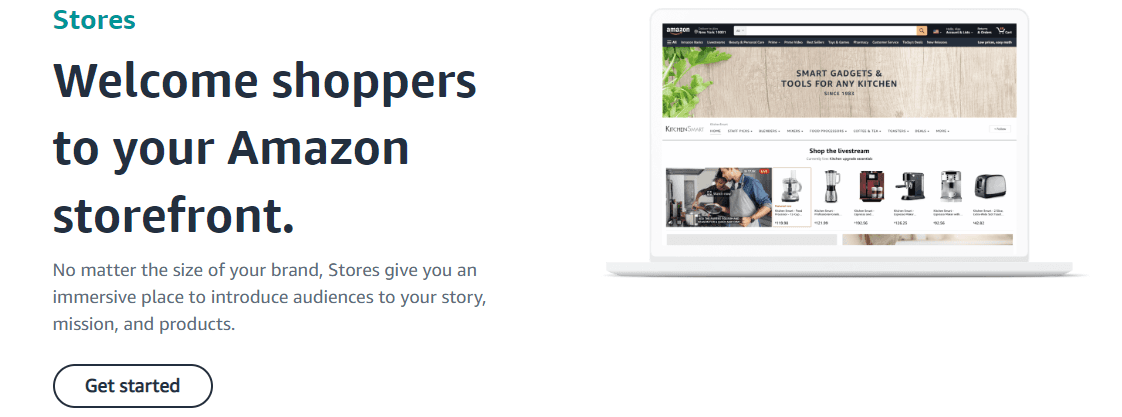
Benefits of Amazon storefront
Create a less generic, more memorable brand presence
Introduce your audience to your brand story, values, and mission
Help shoppers discover your full range of products
Foster brand awareness
Drive traffic to your brand's entire catalog
Eligibility criteria for Amazon storefront
Amazon Storefront is only available to sellers enrolled in the Amazon Brand Registry and vendors selling through Vendor Central. It's free to all eligible brands. Brands that wish to create an Amazon Storefront can contact Amazon design agencies for professional-looking results.
Is it worth investing in Amazon Brand Storefront?
Amazon brand storefront is no longer an exciting new feature. It's a necessity. A well-designed store makes it clear why shoppers should buy from you. Thousands of shoppers who might otherwise know nothing about you can know what your brand and products are all about with one glance at your storefront.
Standing out in a crowded marketplace like Amazon is the only way to make money and keep your brand relevant, so setting up a professional storefront should be at the top of your to-do list.
Tips for creating high-converting storefronts
#1: Create a Deals page
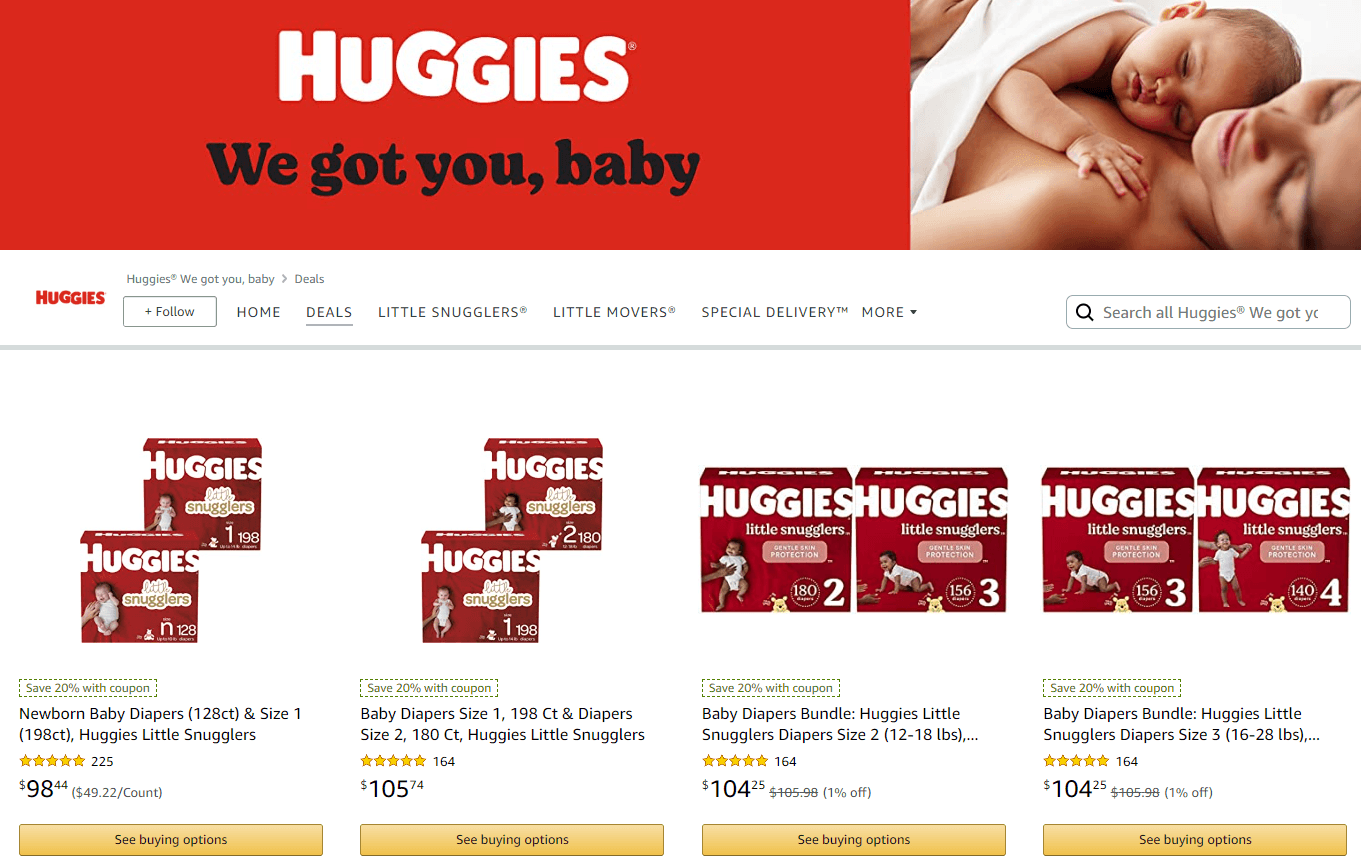
Since your storefront will witness increased traffic during key shopping events like Prime Day and Turkey 5, you'll want to make it easy for shoppers to browse for deals. You can create a dedicated deals page that lists out all the promotions and discount offers on your products.
Depending on the size of your catalog, you can choose to have a single deals page or a main deals page with subpages that feature similar products.
Be sure to add a banner on the home page that links to the deals page for increased visibility. We recommend positioning your deals page right next to the home page in your navigation bar.
#2: Highlight your bestsellers

Creating a bestsellers page on your storefront lets you conveniently add all of your key revenue-generating products in one place. The bestsellers page can also highlight features and USPs of your best selling products to help customers better engage with your products.
#3: Keep your store pages visually fuelled

According to Amazon, storefronts with more than one image and one video saw, on average, 27% higher shoppers' dwell time compared to storefronts without a video or image.
The key to having a visually appealing storefront is excellent creative assets that catch the customer's eye.
#4: Focus on creating an excellent above-the-fold experience
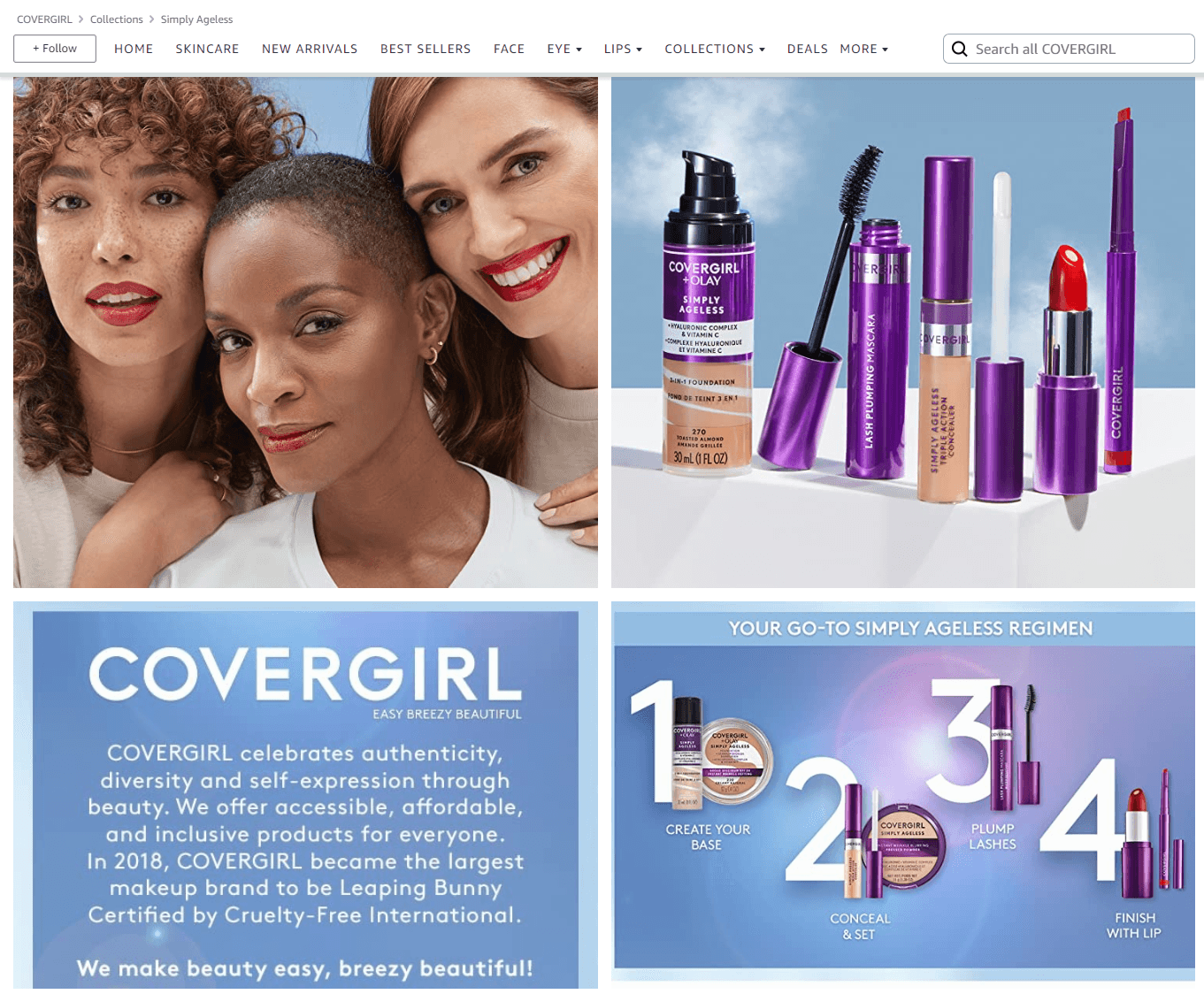
The first viewable section of your storefront should be structured, aligned and able to make a memorable first impression. It's the first thing your shoppers will see and can determine whether to browse further or not.
The above-the-fold content and the rest of the home page should include:
A header image that captures the shopper's attention
A video explaining the brand mission, values, etc. (optional but desirable)
Lifestyle imagery
Short brand description
Tiles that link to your category pages
Featured ASINs
#5: Add a video

According to Wyzowl, 69% of the shoppers said they prefer learning about a new product or service via video over other mediums like text-based articles or infographics. High-quality videos provide a quick and visually engaging way to offer key information about your brand.
#6: Create shoppable images
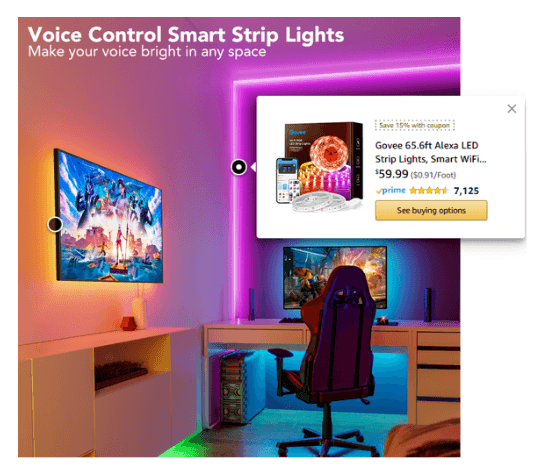
According to Amazon, brands who add a shoppable image to their storefront for the first time see an average 53% increase in shopper dwell time in the next two months compared to those who don't.
With shoppable images, you can choose to make any of the products featured in the image shoppable, enabling customers to click on the product and view basic information such as name, price, customer ratings, Prime availability, etc.
Customers also have the option to add the product to their cart or navigate to the product detail page.
Shoppable images should include a lifestyle that displays your product in various settings or in a collection with complementary products.
#7: Write an impactful copy
Limit the amount of text you write in storefronts. Most shoppers on Amazon are lazy readers
Store copy should replicate your brand's overall tone and identity
Use simple, defined words to make it easy for shoppers to understand your products and brand
Keep sentences short and simple but impactful
Use bulleted lists rather than a dense paragraph
Avoid making unsubstantial claims
#8: Create a page dedicated to your brand
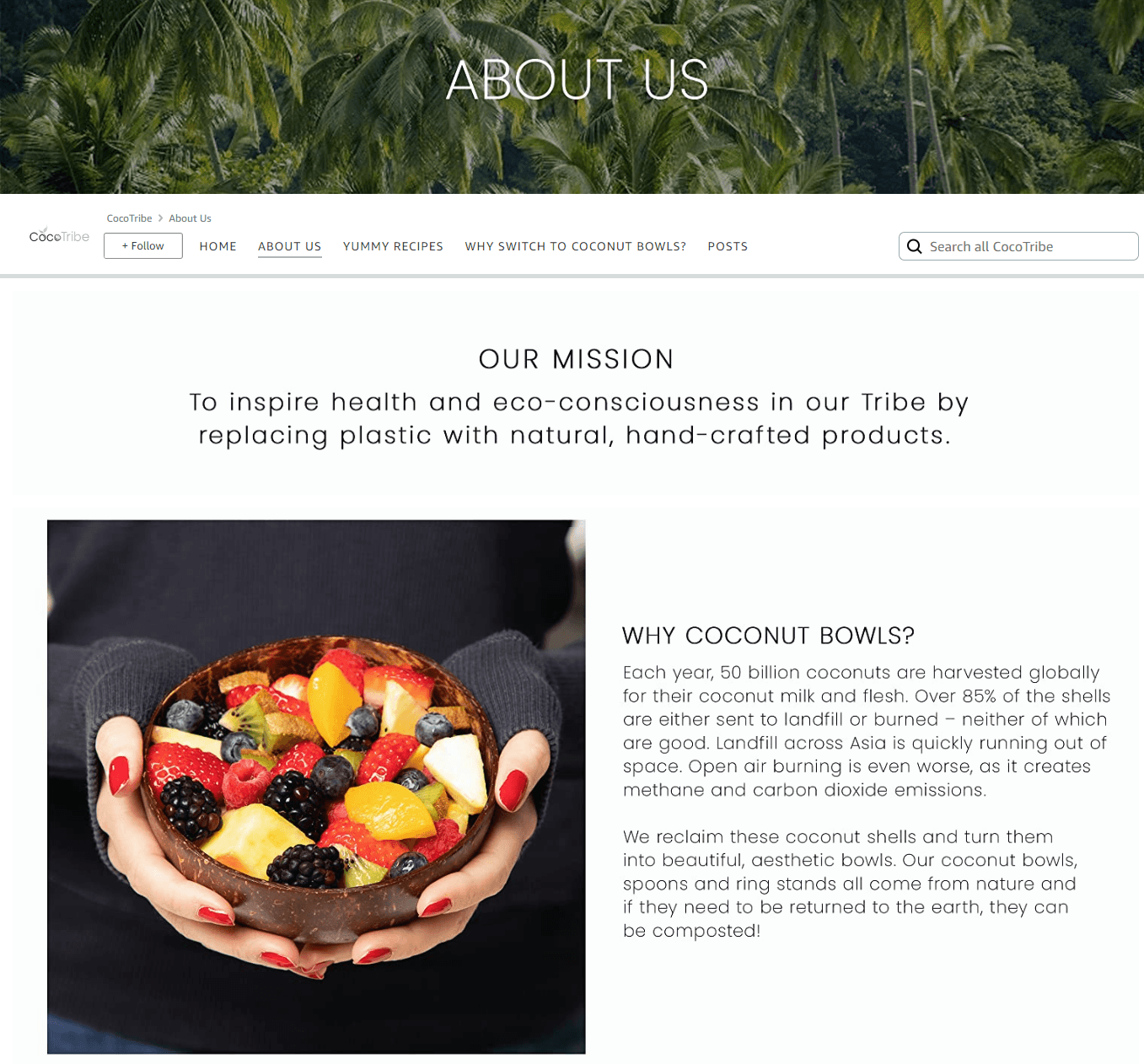
Including unique information about your brand, brand story, mission, vision, values, and ethics helps build your brand identity and keep your brand on top of customers' minds when shopping.
#9: Organize and structure your store
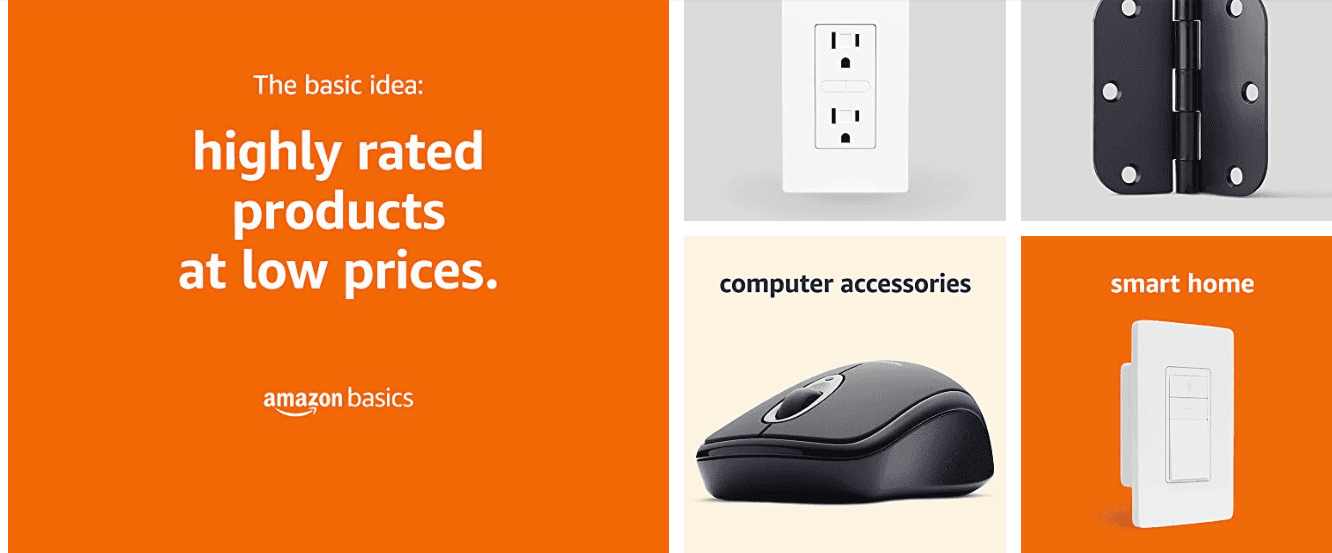
According to Amazon, on average, storefronts with 3+ pages have 83% higher shopper dwell time and 32% higher attributed sales per visitor.
Your store should be easy to navigate and include multiple pages with products neatly categorized on each page. Along with creating merchandising pages like "Deals," "Seasonal," "New arrivals," and "Bestsellers," create category pages such as "Shop by Color," "Shop by occasion," etc.
#10: Optimize for mobile
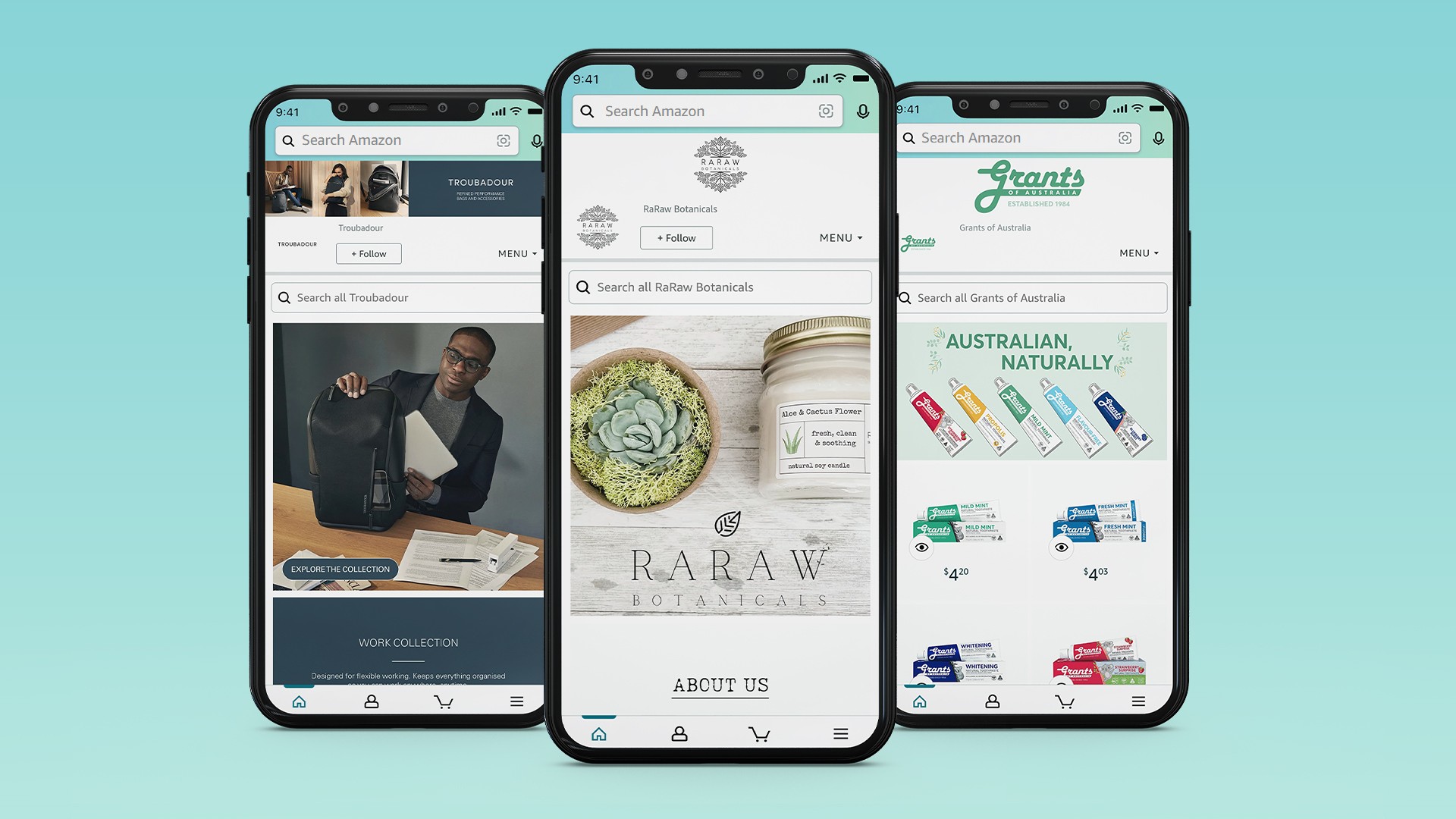
Your store should provide a consistent shopping experience, regardless of screen size. Access your store preview link on your phone or tablet to see if your store looks just as good on smaller screens as it does on a desktop.
Tips to optimize your store for mobile
Ensure all text is legible on mobile without needing to pinch and zoom
Create a layout that makes sense on smaller screens
Use full-width tiles that, unlike smaller split-section tiles, don't break on mobile screens
Your store should be as easy to navigate on mobile as it is on desktop
Post-launch checklist for Amazon storefront
#1: Update the long URL with a short URL
When you first launch your store, a long URL will be automatically generated. Brands can create a ticket with the Amazon support team and ask them for a shortened URL they'd like to have.
#2: Leverage Posts, Brand Follow, and Live to maximize brand visibility
Once your store is up and running, you get access to Amazon's free tools to drive your brand's discoverability, loyalty, and consideration. Leveraging these tools can help sellers establish a consistent brand presence across Amazon.
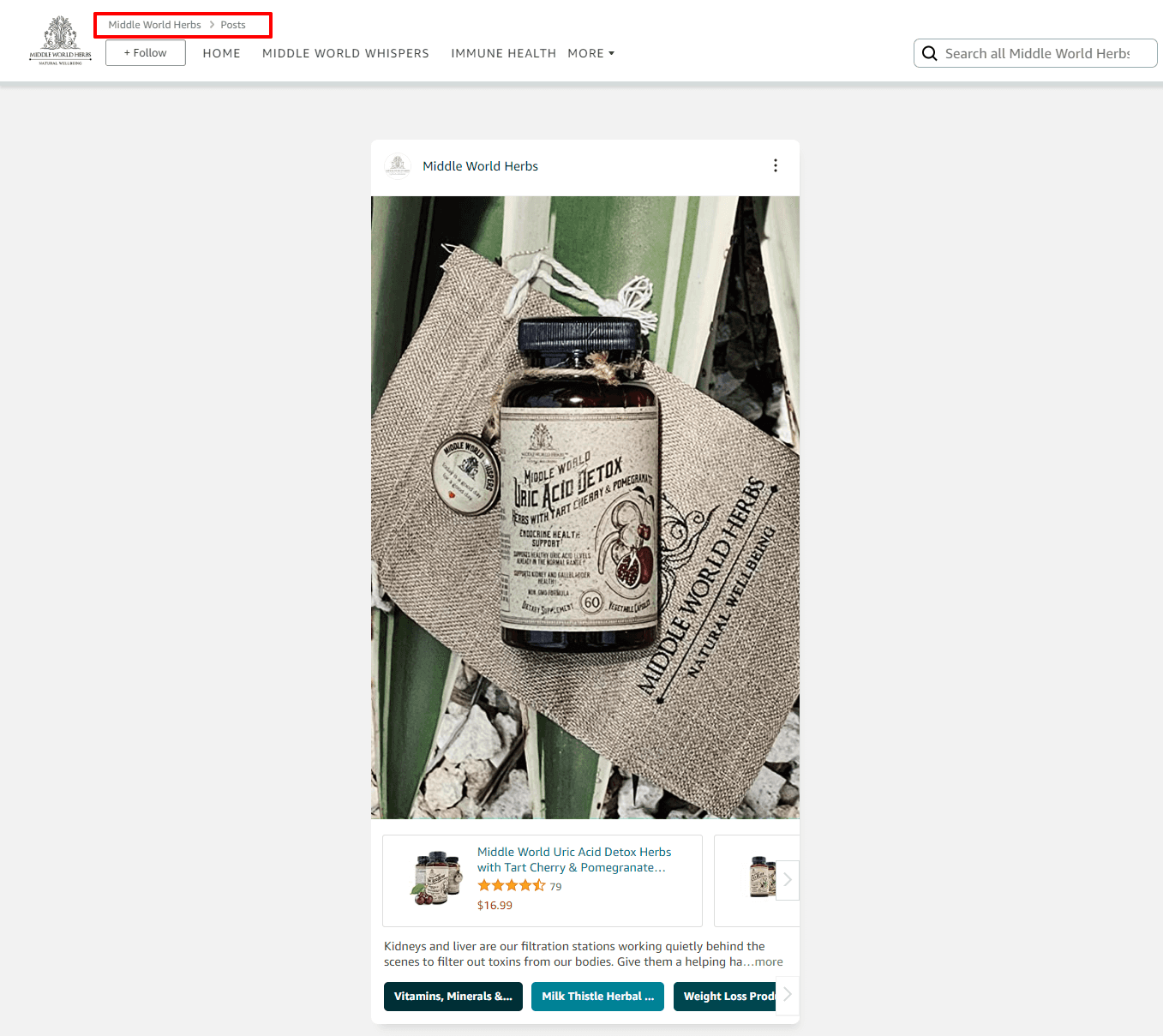
With Posts, brands can share lifestyle content for free as often as they like. Shoppers can interact with Posts, navigate to your product detail pages, explore your brand's feed, discover your storefront, and follow your brand. Posts appear on product detail pages, within dedicated subpages in your store, and in dynamic content feeds. If you create ten live posts as per Amazon's guidelines, they can appear on your product detail pages in a placement dedicated to your brand's posts.
Brand follows:

Shoppers visiting your storefront can choose to follow your brand. You can reach out to your followers via email and notify them about upcoming discount offers and new product launches.
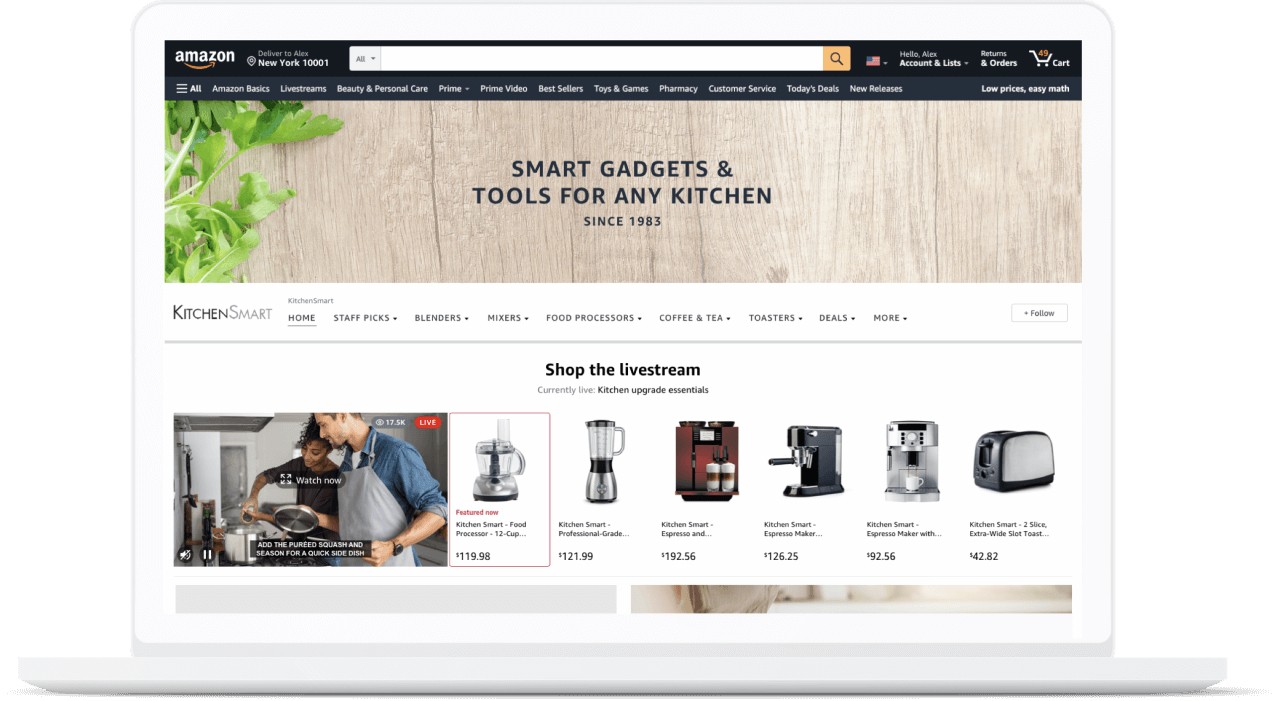
Amazon Live is an interactive streaming platform where brands can conduct live streams to engage with their customers in real time. When brands live stream using Amazon Live, their stream will appear on their US store's home page and will be visible to all shoppers who visit the store for 24 hours after the stream has ended. The prominent placement of the livestream on your storefront makes it a great place to announce special deals and new products.
#3: Increase store traffic
After you've built the store and it's live, it's time for shoppers to find your store. Here are three ways to drive traffic to your storefront:
Sponsored Brands: One of the landing pages for Sponsored Brands is the Amazon storefront. According to Amazon, linking your Sponsored Brands campaign to your store page has 28% better ROI compared to linking to a product list page.
Posts: Shoppers inspired by your content can click through your posts and navigate to your storefront.
External traffic: Share your storefront URL in your social media posts, email marketing campaigns, and your brand's website to reach off-Amazon audiences. Using Stores insights dashboards, you can track the engagement.
#4: Update your store for key events
According to Amazon, storefronts updated within the past 90 days have 21% more repeat visitors and 35% higher attributed sales per visitor.
It's important to keep your store updated as shopping trends change, seasonality occurs, new product launches, or key events like Black Friday and holidays are around the corner. Here are some of the reasons why you should update your store:
New product launch –create a dedicated page for newly launched products.
Seasonality –If your brand sells seasonal products (for example: heaters and fans, Halloween costumes, and Christmas decor), consider updating your category page order, featured products, and look and feel of your store.
Key events –Using the "Store Versions" feature, brands can create different versions of their store for events like Black Friday, Thanksgiving, Christmas, etc.
#5: Performance evaluation and consistent optimization

Want to know which pages have the most visits? How much sales did you make? With the Stores Insights dashboard, brands can view and analyze a variety of metrics that provide clarity into how their store is performing.
Here's a complete list of metrics available in Stores Insights.
Your store needs attention if:
It's not getting enough traffic
It's getting good traffic but low sales
It's getting higher conversion rates on pages with low-traffic
#6: Mirror your website
Your storefront should resemble your website as much as it can. This will provide shoppers with a consistent shopping experience and alert returning customers.
Top 10 Amazon storefronts by eStore Factory
Here's a collection of some of the best-looking storefronts created by eStore Factory. Whether you're launching a store for the first time or want to update your existing obsolete storefront, these storefronts will fuel your imagination:
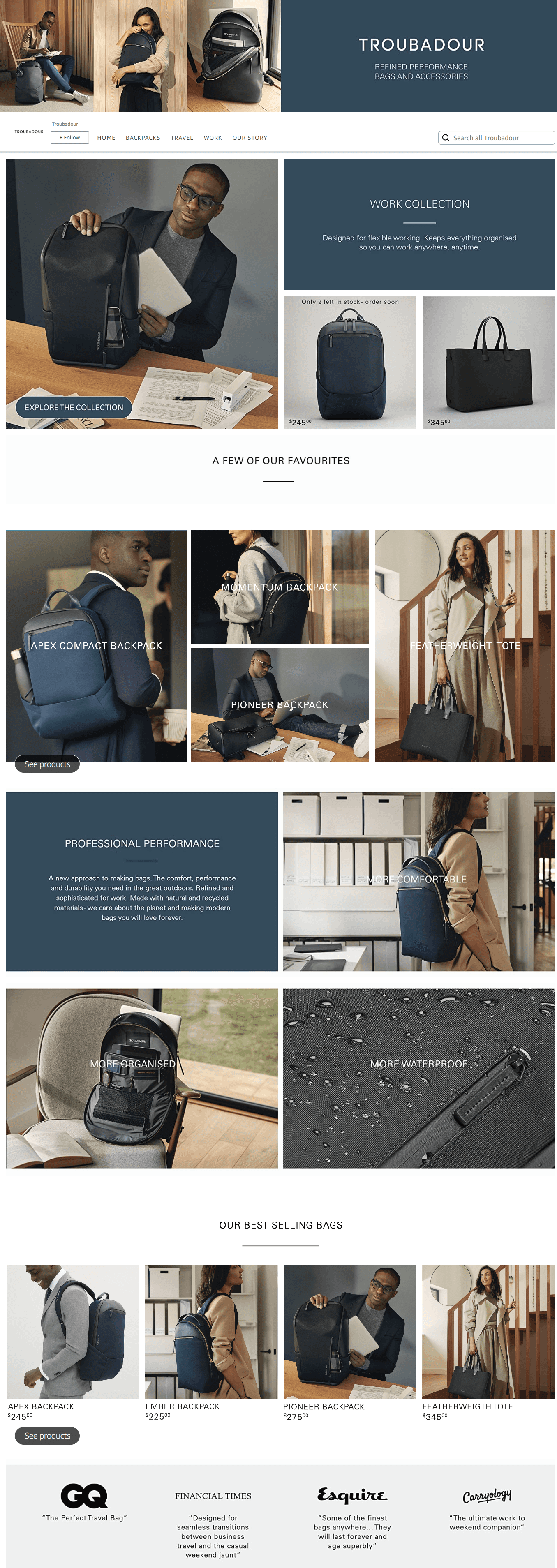
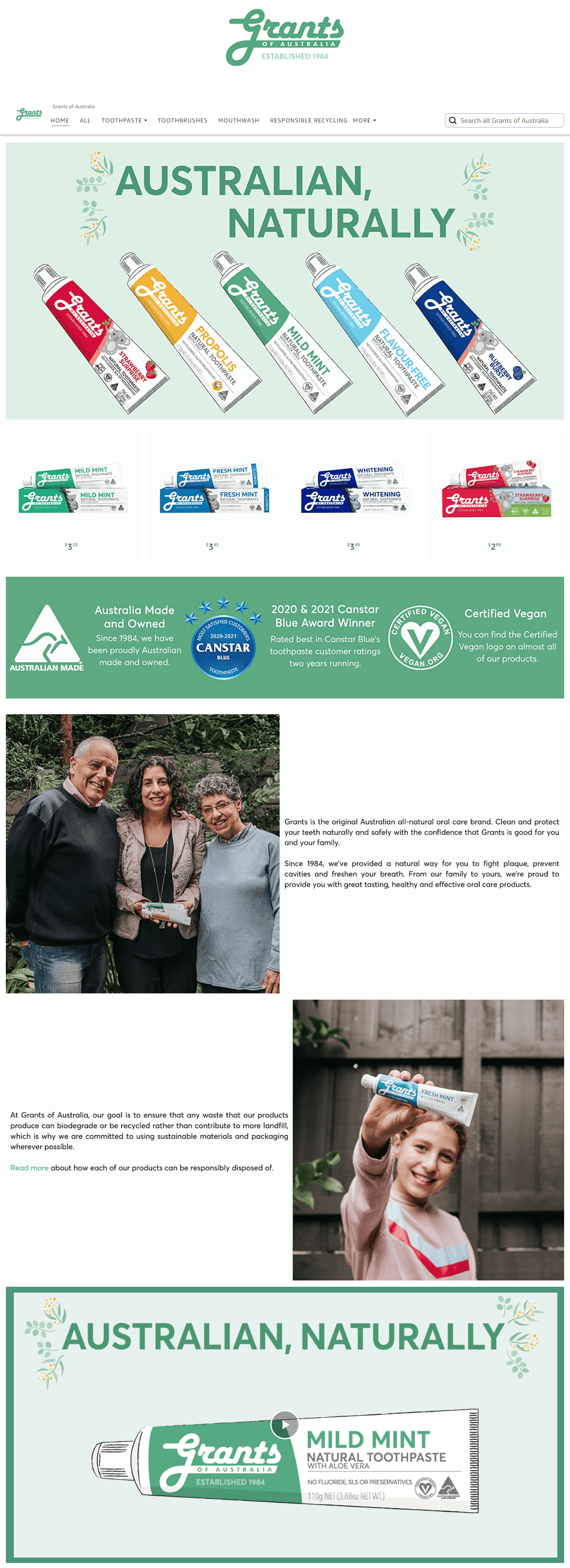


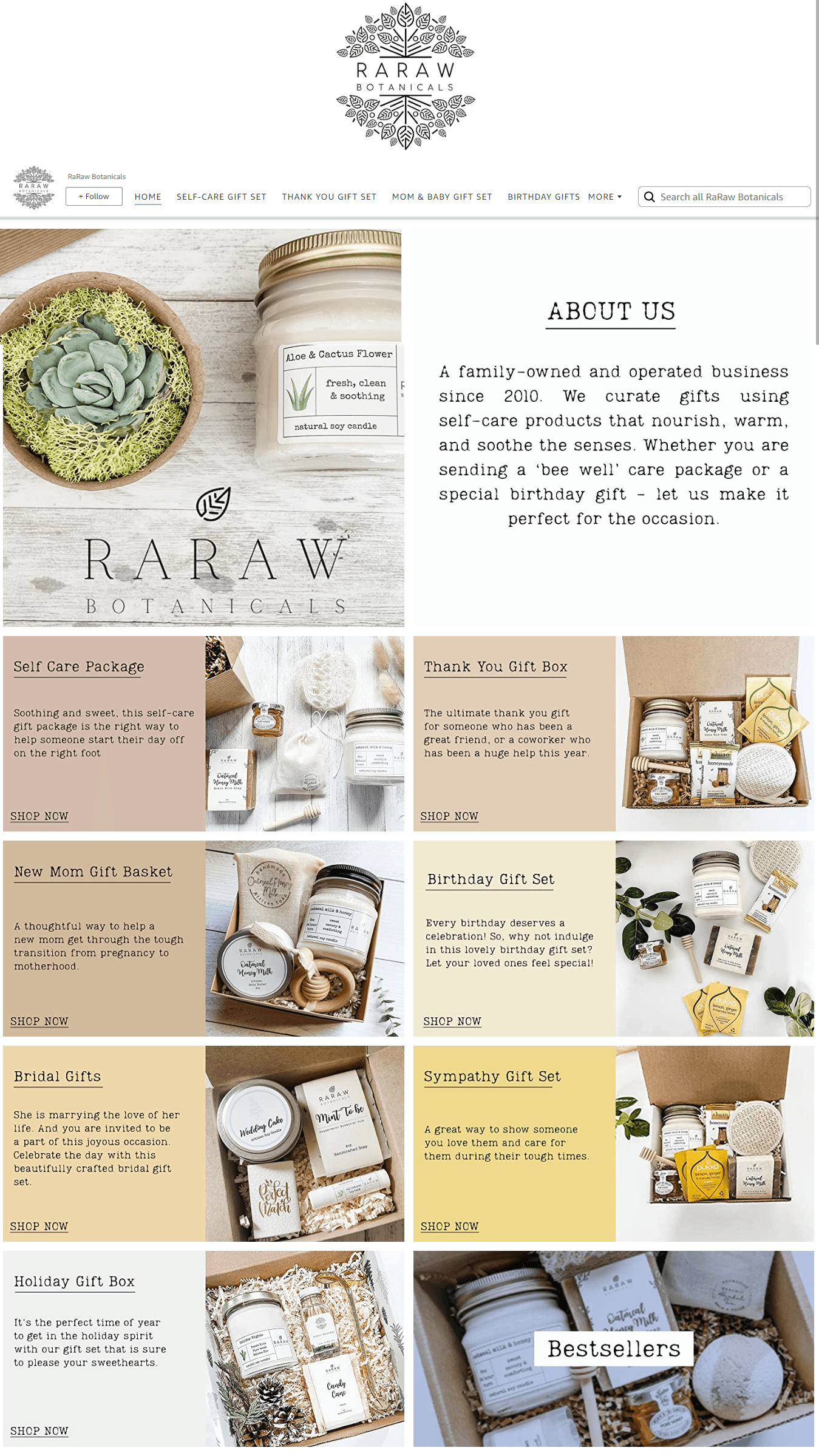
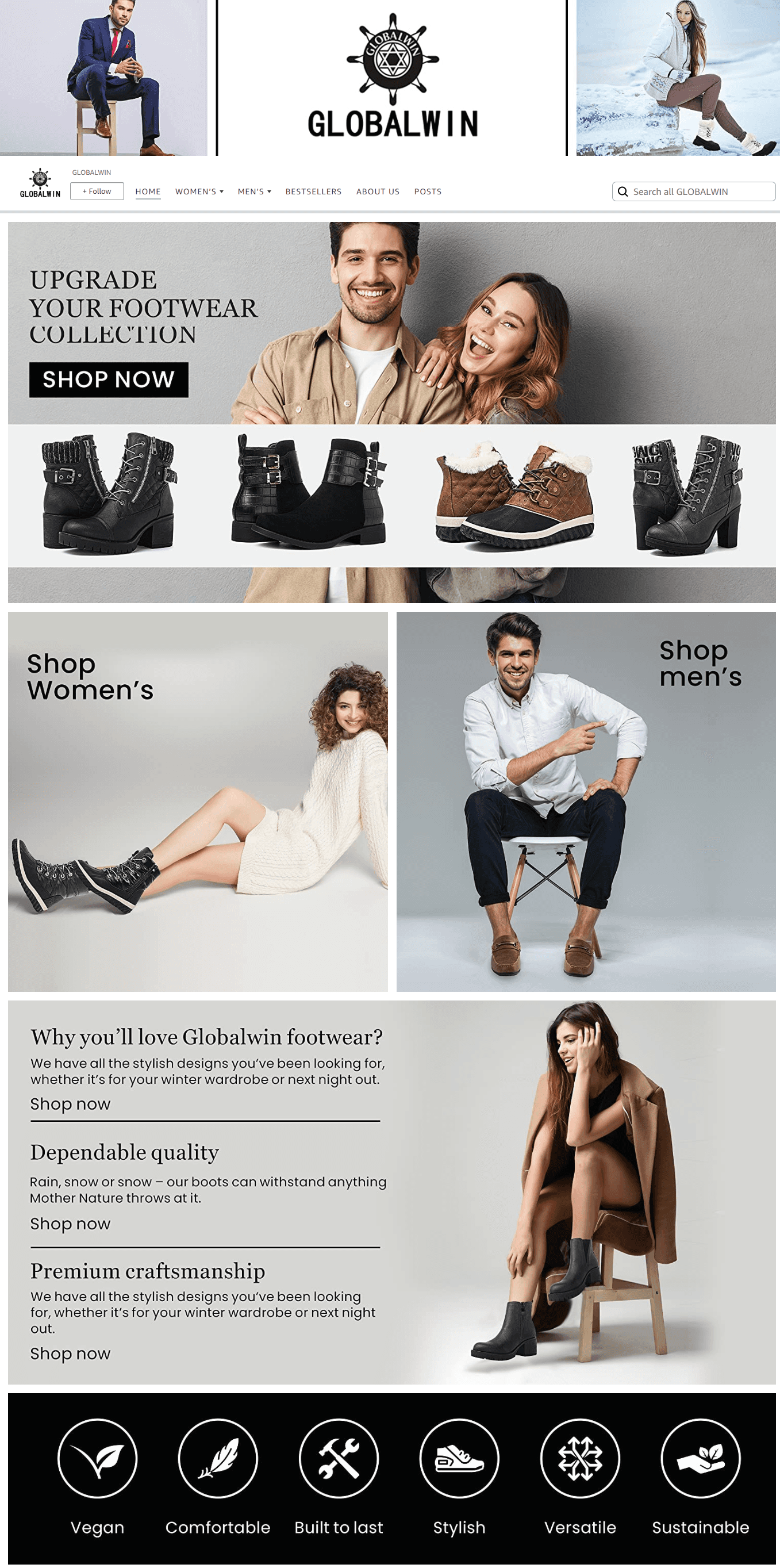




Wrapping it up
With a little help from eStore Factory, all of these featured brands were able to create a unique brand destination on Amazon. Contact our storefront designers if you want a beautiful storefront that illustrates your brand's story and neatly showcases your product portfolio in one convenient destination.
Gone are the days when brands didn't have the tools to differentiate themselves from competing and similar offerings. Features like storefronts allow small and newly launched businesses to look just as savvy and professional as name brands.
Amazon storefront acts as a gateway to your brand where shoppers can know more about your values and get an overview of your product catalog.
Our article contains everything you need to know about Amazon storefronts, including best practices to set up your store for success and stellar Amazon storefronts created by eStore Factory.
What is Amazon Storefront?
Amazon storefront also called Amazon brand store is a mini-me version of your website on Amazon's customer-friendly and trustworthy domain. Using Amazon store creator, eligible brands can showcase their unique brand story and products in a multi-page, immersive shopping experience.

Benefits of Amazon storefront
Create a less generic, more memorable brand presence
Introduce your audience to your brand story, values, and mission
Help shoppers discover your full range of products
Foster brand awareness
Drive traffic to your brand's entire catalog
Eligibility criteria for Amazon storefront
Amazon Storefront is only available to sellers enrolled in the Amazon Brand Registry and vendors selling through Vendor Central. It's free to all eligible brands. Brands that wish to create an Amazon Storefront can contact Amazon design agencies for professional-looking results.
Is it worth investing in Amazon Brand Storefront?
Amazon brand storefront is no longer an exciting new feature. It's a necessity. A well-designed store makes it clear why shoppers should buy from you. Thousands of shoppers who might otherwise know nothing about you can know what your brand and products are all about with one glance at your storefront.
Standing out in a crowded marketplace like Amazon is the only way to make money and keep your brand relevant, so setting up a professional storefront should be at the top of your to-do list.
Tips for creating high-converting storefronts
#1: Create a Deals page

Since your storefront will witness increased traffic during key shopping events like Prime Day and Turkey 5, you'll want to make it easy for shoppers to browse for deals. You can create a dedicated deals page that lists out all the promotions and discount offers on your products.
Depending on the size of your catalog, you can choose to have a single deals page or a main deals page with subpages that feature similar products.
Be sure to add a banner on the home page that links to the deals page for increased visibility. We recommend positioning your deals page right next to the home page in your navigation bar.
#2: Highlight your bestsellers

Creating a bestsellers page on your storefront lets you conveniently add all of your key revenue-generating products in one place. The bestsellers page can also highlight features and USPs of your best selling products to help customers better engage with your products.
#3: Keep your store pages visually fuelled

According to Amazon, storefronts with more than one image and one video saw, on average, 27% higher shoppers' dwell time compared to storefronts without a video or image.
The key to having a visually appealing storefront is excellent creative assets that catch the customer's eye.
#4: Focus on creating an excellent above-the-fold experience

The first viewable section of your storefront should be structured, aligned and able to make a memorable first impression. It's the first thing your shoppers will see and can determine whether to browse further or not.
The above-the-fold content and the rest of the home page should include:
A header image that captures the shopper's attention
A video explaining the brand mission, values, etc. (optional but desirable)
Lifestyle imagery
Short brand description
Tiles that link to your category pages
Featured ASINs
#5: Add a video

According to Wyzowl, 69% of the shoppers said they prefer learning about a new product or service via video over other mediums like text-based articles or infographics. High-quality videos provide a quick and visually engaging way to offer key information about your brand.
#6: Create shoppable images

According to Amazon, brands who add a shoppable image to their storefront for the first time see an average 53% increase in shopper dwell time in the next two months compared to those who don't.
With shoppable images, you can choose to make any of the products featured in the image shoppable, enabling customers to click on the product and view basic information such as name, price, customer ratings, Prime availability, etc.
Customers also have the option to add the product to their cart or navigate to the product detail page.
Shoppable images should include a lifestyle that displays your product in various settings or in a collection with complementary products.
#7: Write an impactful copy
Limit the amount of text you write in storefronts. Most shoppers on Amazon are lazy readers
Store copy should replicate your brand's overall tone and identity
Use simple, defined words to make it easy for shoppers to understand your products and brand
Keep sentences short and simple but impactful
Use bulleted lists rather than a dense paragraph
Avoid making unsubstantial claims
#8: Create a page dedicated to your brand

Including unique information about your brand, brand story, mission, vision, values, and ethics helps build your brand identity and keep your brand on top of customers' minds when shopping.
#9: Organize and structure your store

According to Amazon, on average, storefronts with 3+ pages have 83% higher shopper dwell time and 32% higher attributed sales per visitor.
Your store should be easy to navigate and include multiple pages with products neatly categorized on each page. Along with creating merchandising pages like "Deals," "Seasonal," "New arrivals," and "Bestsellers," create category pages such as "Shop by Color," "Shop by occasion," etc.
#10: Optimize for mobile

Your store should provide a consistent shopping experience, regardless of screen size. Access your store preview link on your phone or tablet to see if your store looks just as good on smaller screens as it does on a desktop.
Tips to optimize your store for mobile
Ensure all text is legible on mobile without needing to pinch and zoom
Create a layout that makes sense on smaller screens
Use full-width tiles that, unlike smaller split-section tiles, don't break on mobile screens
Your store should be as easy to navigate on mobile as it is on desktop
Post-launch checklist for Amazon storefront
#1: Update the long URL with a short URL
When you first launch your store, a long URL will be automatically generated. Brands can create a ticket with the Amazon support team and ask them for a shortened URL they'd like to have.
#2: Leverage Posts, Brand Follow, and Live to maximize brand visibility
Once your store is up and running, you get access to Amazon's free tools to drive your brand's discoverability, loyalty, and consideration. Leveraging these tools can help sellers establish a consistent brand presence across Amazon.

With Posts, brands can share lifestyle content for free as often as they like. Shoppers can interact with Posts, navigate to your product detail pages, explore your brand's feed, discover your storefront, and follow your brand. Posts appear on product detail pages, within dedicated subpages in your store, and in dynamic content feeds. If you create ten live posts as per Amazon's guidelines, they can appear on your product detail pages in a placement dedicated to your brand's posts.
Brand follows:

Shoppers visiting your storefront can choose to follow your brand. You can reach out to your followers via email and notify them about upcoming discount offers and new product launches.

Amazon Live is an interactive streaming platform where brands can conduct live streams to engage with their customers in real time. When brands live stream using Amazon Live, their stream will appear on their US store's home page and will be visible to all shoppers who visit the store for 24 hours after the stream has ended. The prominent placement of the livestream on your storefront makes it a great place to announce special deals and new products.
#3: Increase store traffic
After you've built the store and it's live, it's time for shoppers to find your store. Here are three ways to drive traffic to your storefront:
Sponsored Brands: One of the landing pages for Sponsored Brands is the Amazon storefront. According to Amazon, linking your Sponsored Brands campaign to your store page has 28% better ROI compared to linking to a product list page.
Posts: Shoppers inspired by your content can click through your posts and navigate to your storefront.
External traffic: Share your storefront URL in your social media posts, email marketing campaigns, and your brand's website to reach off-Amazon audiences. Using Stores insights dashboards, you can track the engagement.
#4: Update your store for key events
According to Amazon, storefronts updated within the past 90 days have 21% more repeat visitors and 35% higher attributed sales per visitor.
It's important to keep your store updated as shopping trends change, seasonality occurs, new product launches, or key events like Black Friday and holidays are around the corner. Here are some of the reasons why you should update your store:
New product launch –create a dedicated page for newly launched products.
Seasonality –If your brand sells seasonal products (for example: heaters and fans, Halloween costumes, and Christmas decor), consider updating your category page order, featured products, and look and feel of your store.
Key events –Using the "Store Versions" feature, brands can create different versions of their store for events like Black Friday, Thanksgiving, Christmas, etc.
#5: Performance evaluation and consistent optimization

Want to know which pages have the most visits? How much sales did you make? With the Stores Insights dashboard, brands can view and analyze a variety of metrics that provide clarity into how their store is performing.
Here's a complete list of metrics available in Stores Insights.
Your store needs attention if:
It's not getting enough traffic
It's getting good traffic but low sales
It's getting higher conversion rates on pages with low-traffic
#6: Mirror your website
Your storefront should resemble your website as much as it can. This will provide shoppers with a consistent shopping experience and alert returning customers.
Top 10 Amazon storefronts by eStore Factory
Here's a collection of some of the best-looking storefronts created by eStore Factory. Whether you're launching a store for the first time or want to update your existing obsolete storefront, these storefronts will fuel your imagination:










Wrapping it up
With a little help from eStore Factory, all of these featured brands were able to create a unique brand destination on Amazon. Contact our storefront designers if you want a beautiful storefront that illustrates your brand's story and neatly showcases your product portfolio in one convenient destination.
Gone are the days when brands didn't have the tools to differentiate themselves from competing and similar offerings. Features like storefronts allow small and newly launched businesses to look just as savvy and professional as name brands.
Amazon storefront acts as a gateway to your brand where shoppers can know more about your values and get an overview of your product catalog.
Our article contains everything you need to know about Amazon storefronts, including best practices to set up your store for success and stellar Amazon storefronts created by eStore Factory.
What is Amazon Storefront?
Amazon storefront also called Amazon brand store is a mini-me version of your website on Amazon's customer-friendly and trustworthy domain. Using Amazon store creator, eligible brands can showcase their unique brand story and products in a multi-page, immersive shopping experience.

Benefits of Amazon storefront
Create a less generic, more memorable brand presence
Introduce your audience to your brand story, values, and mission
Help shoppers discover your full range of products
Foster brand awareness
Drive traffic to your brand's entire catalog
Eligibility criteria for Amazon storefront
Amazon Storefront is only available to sellers enrolled in the Amazon Brand Registry and vendors selling through Vendor Central. It's free to all eligible brands. Brands that wish to create an Amazon Storefront can contact Amazon design agencies for professional-looking results.
Is it worth investing in Amazon Brand Storefront?
Amazon brand storefront is no longer an exciting new feature. It's a necessity. A well-designed store makes it clear why shoppers should buy from you. Thousands of shoppers who might otherwise know nothing about you can know what your brand and products are all about with one glance at your storefront.
Standing out in a crowded marketplace like Amazon is the only way to make money and keep your brand relevant, so setting up a professional storefront should be at the top of your to-do list.
Tips for creating high-converting storefronts
#1: Create a Deals page

Since your storefront will witness increased traffic during key shopping events like Prime Day and Turkey 5, you'll want to make it easy for shoppers to browse for deals. You can create a dedicated deals page that lists out all the promotions and discount offers on your products.
Depending on the size of your catalog, you can choose to have a single deals page or a main deals page with subpages that feature similar products.
Be sure to add a banner on the home page that links to the deals page for increased visibility. We recommend positioning your deals page right next to the home page in your navigation bar.
#2: Highlight your bestsellers

Creating a bestsellers page on your storefront lets you conveniently add all of your key revenue-generating products in one place. The bestsellers page can also highlight features and USPs of your best selling products to help customers better engage with your products.
#3: Keep your store pages visually fuelled

According to Amazon, storefronts with more than one image and one video saw, on average, 27% higher shoppers' dwell time compared to storefronts without a video or image.
The key to having a visually appealing storefront is excellent creative assets that catch the customer's eye.
#4: Focus on creating an excellent above-the-fold experience

The first viewable section of your storefront should be structured, aligned and able to make a memorable first impression. It's the first thing your shoppers will see and can determine whether to browse further or not.
The above-the-fold content and the rest of the home page should include:
A header image that captures the shopper's attention
A video explaining the brand mission, values, etc. (optional but desirable)
Lifestyle imagery
Short brand description
Tiles that link to your category pages
Featured ASINs
#5: Add a video

According to Wyzowl, 69% of the shoppers said they prefer learning about a new product or service via video over other mediums like text-based articles or infographics. High-quality videos provide a quick and visually engaging way to offer key information about your brand.
#6: Create shoppable images

According to Amazon, brands who add a shoppable image to their storefront for the first time see an average 53% increase in shopper dwell time in the next two months compared to those who don't.
With shoppable images, you can choose to make any of the products featured in the image shoppable, enabling customers to click on the product and view basic information such as name, price, customer ratings, Prime availability, etc.
Customers also have the option to add the product to their cart or navigate to the product detail page.
Shoppable images should include a lifestyle that displays your product in various settings or in a collection with complementary products.
#7: Write an impactful copy
Limit the amount of text you write in storefronts. Most shoppers on Amazon are lazy readers
Store copy should replicate your brand's overall tone and identity
Use simple, defined words to make it easy for shoppers to understand your products and brand
Keep sentences short and simple but impactful
Use bulleted lists rather than a dense paragraph
Avoid making unsubstantial claims
#8: Create a page dedicated to your brand

Including unique information about your brand, brand story, mission, vision, values, and ethics helps build your brand identity and keep your brand on top of customers' minds when shopping.
#9: Organize and structure your store

According to Amazon, on average, storefronts with 3+ pages have 83% higher shopper dwell time and 32% higher attributed sales per visitor.
Your store should be easy to navigate and include multiple pages with products neatly categorized on each page. Along with creating merchandising pages like "Deals," "Seasonal," "New arrivals," and "Bestsellers," create category pages such as "Shop by Color," "Shop by occasion," etc.
#10: Optimize for mobile

Your store should provide a consistent shopping experience, regardless of screen size. Access your store preview link on your phone or tablet to see if your store looks just as good on smaller screens as it does on a desktop.
Tips to optimize your store for mobile
Ensure all text is legible on mobile without needing to pinch and zoom
Create a layout that makes sense on smaller screens
Use full-width tiles that, unlike smaller split-section tiles, don't break on mobile screens
Your store should be as easy to navigate on mobile as it is on desktop
Post-launch checklist for Amazon storefront
#1: Update the long URL with a short URL
When you first launch your store, a long URL will be automatically generated. Brands can create a ticket with the Amazon support team and ask them for a shortened URL they'd like to have.
#2: Leverage Posts, Brand Follow, and Live to maximize brand visibility
Once your store is up and running, you get access to Amazon's free tools to drive your brand's discoverability, loyalty, and consideration. Leveraging these tools can help sellers establish a consistent brand presence across Amazon.

With Posts, brands can share lifestyle content for free as often as they like. Shoppers can interact with Posts, navigate to your product detail pages, explore your brand's feed, discover your storefront, and follow your brand. Posts appear on product detail pages, within dedicated subpages in your store, and in dynamic content feeds. If you create ten live posts as per Amazon's guidelines, they can appear on your product detail pages in a placement dedicated to your brand's posts.
Brand follows:

Shoppers visiting your storefront can choose to follow your brand. You can reach out to your followers via email and notify them about upcoming discount offers and new product launches.

Amazon Live is an interactive streaming platform where brands can conduct live streams to engage with their customers in real time. When brands live stream using Amazon Live, their stream will appear on their US store's home page and will be visible to all shoppers who visit the store for 24 hours after the stream has ended. The prominent placement of the livestream on your storefront makes it a great place to announce special deals and new products.
#3: Increase store traffic
After you've built the store and it's live, it's time for shoppers to find your store. Here are three ways to drive traffic to your storefront:
Sponsored Brands: One of the landing pages for Sponsored Brands is the Amazon storefront. According to Amazon, linking your Sponsored Brands campaign to your store page has 28% better ROI compared to linking to a product list page.
Posts: Shoppers inspired by your content can click through your posts and navigate to your storefront.
External traffic: Share your storefront URL in your social media posts, email marketing campaigns, and your brand's website to reach off-Amazon audiences. Using Stores insights dashboards, you can track the engagement.
#4: Update your store for key events
According to Amazon, storefronts updated within the past 90 days have 21% more repeat visitors and 35% higher attributed sales per visitor.
It's important to keep your store updated as shopping trends change, seasonality occurs, new product launches, or key events like Black Friday and holidays are around the corner. Here are some of the reasons why you should update your store:
New product launch –create a dedicated page for newly launched products.
Seasonality –If your brand sells seasonal products (for example: heaters and fans, Halloween costumes, and Christmas decor), consider updating your category page order, featured products, and look and feel of your store.
Key events –Using the "Store Versions" feature, brands can create different versions of their store for events like Black Friday, Thanksgiving, Christmas, etc.
#5: Performance evaluation and consistent optimization

Want to know which pages have the most visits? How much sales did you make? With the Stores Insights dashboard, brands can view and analyze a variety of metrics that provide clarity into how their store is performing.
Here's a complete list of metrics available in Stores Insights.
Your store needs attention if:
It's not getting enough traffic
It's getting good traffic but low sales
It's getting higher conversion rates on pages with low-traffic
#6: Mirror your website
Your storefront should resemble your website as much as it can. This will provide shoppers with a consistent shopping experience and alert returning customers.
Top 10 Amazon storefronts by eStore Factory
Here's a collection of some of the best-looking storefronts created by eStore Factory. Whether you're launching a store for the first time or want to update your existing obsolete storefront, these storefronts will fuel your imagination:










Wrapping it up
With a little help from eStore Factory, all of these featured brands were able to create a unique brand destination on Amazon. Contact our storefront designers if you want a beautiful storefront that illustrates your brand's story and neatly showcases your product portfolio in one convenient destination.









